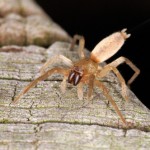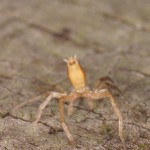This spider is a little guy, and that is the only reason his mode of transport works. When the Stegodyphus wants to move long distances it takes to the wind. It will raise its tail in the air and release a large amount of threads in the air. After it has released enough the wind will create enough lift for it to actually take off.
There are 21 different species of the Stegodyphus. Most are found in Africa, Europe and Asia. There are a few species that have made their way to Brazil. Not all species of Stegodyphus use ballooning as a form of dispersal.
These creatures are very small with an average length of only 10mm, and an average weight of only 85 to 150mg. This small mass and body size are the reason that it is able to be carried away by the wind. This type of transportation obviously has a very small mass limit. The spider lets out 3 to 4 strands of thread to induce this floating transportation, each a length of about 60 to 80 centimeters for an overall length of 1.8 to 3.2 meters. The original study states that they can reach altitudes of over 1000 meters above the ground.
The most recent study has shown that the Stegodyphus is able to gain altitude after releasing many strands of silk. These fan out to create a large surface area, which enables larger or more massive spiders to disperse as well. Although they have no ability to maneuver while in the air it is impressive that they have found such a unique way to disperse themselves. This technique obviously works well, because they have spanned to four different continents.
I was unable to find a video of this happening, but a few pictures illustrate just how this works. In the first one you can see how they raise their tails to begin releasing the thread. In the second photo if you look closely behind its tail you can see some of the thread.
- Look closely behind its tail to see the thread.
- Stegodyphus raising its tail.
___________________________________________
References
1. Wickler and Seibt. Springer Link. Aerial Disperal by Ballooning in Adult Stegodyphus mimosarum, 1986. 2 Oct. 2011.
2. Joh R. Henschel, Jutta Schneider and Yael D. Lubin. Journal of Arachnology. Dispersal Mechanisms of Stegodyphys: Do They Balloon?, 1995. 2 Oct. 2011
3. Jutta M. Schneider, Jörg Roos, Yael Lubin, and Johannes R. Henschel. Journal of Arachnology. Dispersal of Stegodyphus Dumicola: They Do Balloon After All! 2001. 2 Oct 2011.

